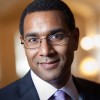The beauty of Gambier in the springtime both connects us to the earth — the shoots of green leaves emerging from tree branches, the freshness of the air, the murmur of the Kokosing — and energizes our desire to protect it. It is especially fitting for us that Earth Day is celebrated at this time of the year. And while our unspoiled rural Ohio community may sometimes seem impervious to environmental threats, we know that climate change will eventually touch every place in its own way. I’ve been reflecting on how to confront the threats climate change will pose to all of us during Kenyon’s upcoming third century of existence, challenges that governments worldwide — despite making some real progress — still seem woefully underprepared to fully confront.
This awareness of the increasing scale and pace of climate change has recently reached a fever pitch, especially among the generation of students Kenyon serves today. Large numbers of young people report feelings of anxiety and helplessness when faced with the reality of an increasingly inhospitable — though not unlivable — planet in the future. Despite many distressing warning signs, I think it’s important to find room for hope — taking note of positive developments in pro-climate policies and technologies, and following the lead of pragmatic activists profiled by the New York Times who neither subscribe to “doomerism” nor adopt the deus-ex-machina idea that everything will somehow work out for the best without continuous effort on all of our parts.
This blend of realism and optimism is what Kenyon is striving for in setting ambitious sustainability goals. We cannot achieve carbon neutrality immediately, but we have purchased enough renewable energy credits to cover 100% of our electricity needs. We cannot cut ourselves off from Ohio’s coal-heavy electrical grid, but thanks to the work of students in the “Solar Power Systems” class, we have installed four photovoltaic projects across campus — and an upcoming installation on the roof of Gund Commons will be the largest yet, producing up to 80,000 kilowatt-hours per year and at some points feeding extra energy to the grid when more electricity is produced than the building can consume.
Perhaps most importantly, we have taken a significant step forward by starting a partnership this semester with Ever-Green Energy, a consulting group with deep expertise in ecological systems and carbon sequestration that has worked with several other colleges on large-scale projects to identify low-carbon energy solutions and develop carbon neutrality master plans. This plan will recommend specific actions and timelines to chart a path from 2023 to 2040, our deadline for achieving carbon neutrality.
We aim to take a uniquely holistic approach to carbon neutrality planning by considering ecological solutions as part of the plan. In other words, Kenyon will look to reduce the amount of carbon put into the atmosphere, while also increasing the amount of atmospheric carbon that is removed and stored in soil and vegetation. Our plan will aim to balance the dynamic nature of technology and the need for pragmatic solutions that are cost-effective and implementable.
Ever-Green will lead the energy system work by evaluating campus energy data and assessing the existing energy infrastructure. The team will then analyze the low-carbon solutions available to Kenyon, with consideration for short-term and long-term priorities. Planning will be overseen by the Office of Green Initiatives and Vice President for Facilities, Planning and Sustainability Ian Smith, with the assistance of a steering committee to be named. I’m excited to move forward with this work, and look forward to sharing more updates on this work and the development of the steering committee in the coming months.
As the climate advocate Mary Annaïse Heglar said in the Times article I cited above, “We don’t know till we try if we’re going to win” the battle against climate change, but “whether or not we do, it will still have been worth it.” I’m confident that, at Kenyon, we have the ability to truly try. We will take on this critical work with integrity, imagination and a special kind of environmental stewardship, given our deep connection to this place.
